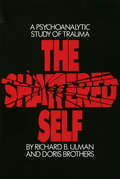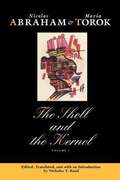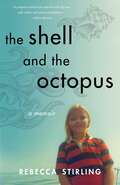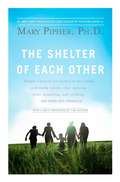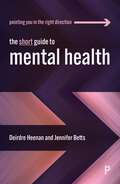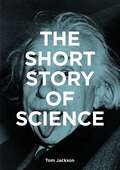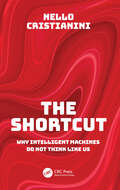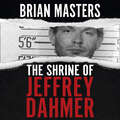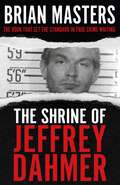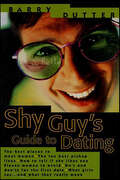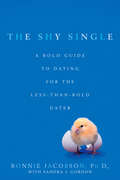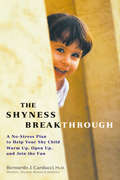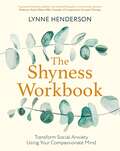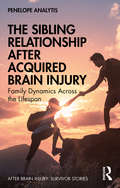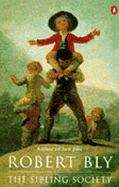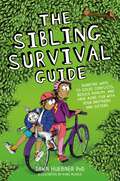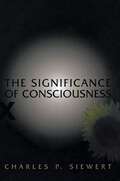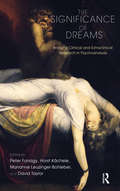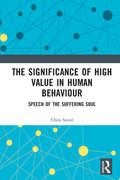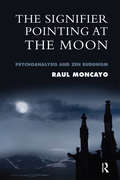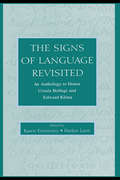- Table View
- List View
The Shattered Self: A Psychoanalytic Study of Trauma
by Doris Brothers Richard B. UlmanUlman and Brothers utilize a unique clinical research population of rape and incest victims and Vietnam combat veterans to argue that trauma results from real occurrences that have, as their unconscious meaning, the shattering of "central organizing fantasies" of self in relation to selfobject. Their innovative treatment approach revolves around the transformation of these shattered fantasies in the intersubjective context of the transference-countertransference neurosis.
The Shell and the Kernel: Renewals of Psychoanalysis, Volume 1
by Nicolas Abraham Maria Torok Nicholas Rant Nicholas Rand<p>This volume is a superb introduction to the richness and originality of Abraham and Torok's approach to psychoanalysis and their psychoanalytic approach to literature. Abraham and Torok advocate a form of psychoanalysis that insists on the particularity of any individual's life story, the specificity of texts, and the singularity of historical situations. In what is both a critique and an extension of Freud, they develop interpretive strategies with powerful implications for clinicians, literary theorists, feminists, philosophers, and all others interested in the uses and limits of psychoanalysis. <p>Central to their approach is a general theory of psychic concealment, a poetics of hiding. Whether in a clinical setting or a literary text, they search out the unspeakable secret as a symptom of devastating trauma revealed only in linguistic or behavioral encodings. Their view of trauma provides the linchpin for new psychic and linguistic structures such as the "transgenerational phantom," an undisclosed family secret handed down to an unwitting descendant, and the intra-psychic secret or "crypt," which entombs an unspeakable but consummated desire. Throughout, Abraham and Torok seek to restore communication with those intimate recesses of the mind which are, for one reason or another, denied expression. <p>Classics of French theory and practice, the essays in volume one include four previously uncollected works by Maria Torok. Nicholas Rand supplies a substantial introductory essay and commentary throughout. Abraham and Torok's theories of fractured meaning and their search for coherence in the face of discontinuity and disruption have the potential to reshape not only psychoanalysis but all disciplines concerned with issues of textual, oral, or visual interpretation.</p>
The Shell and the Octopus: A Memoir
by Rebecca StirlingThis is the story of Rebecca Stirling&’s childhood: a young girl raised by the sea, by men, and by literature. Circumnavigating the world on a thirty-foot sailboat, the Stirlings spend weeks at a time on the open ocean, surviving storms and visiting uncharted islands and villages. Ushered through her young life by a father who loves adventure, women, and extremes, Rebecca befriends &“working girls&” in the ports they visit (as they are often the only other females present in the bars that they end up in) and, on the boat, falls in love with her crewmate and learns to live like the men around her. But her driven nature and the role models in the books she reads make her determined to be a lady, continue her education, begin a career, live in a real home, and begin a family of her own. Once she finally gets away from the boat and her dad and sets to work upon making her own dream a reality, however, Rebecca begins to realize life is not what she thought it would be—and when her father dies in a tragic accident, she must return to her old life to sift through the mess and magic he has left behind.
The Shelter of Each Other
by Mary Pipher"Simple solutions for survival in this family-unfriendly culture...Eye-opening...heart-wrenching and uplifting."--San Francisco Chronicle Even more resonant today than at its original publication twelve years ago, The Shelter of Each Other traces the effects of our society's "anti-family" way of life, where parents are overtaxed, children are undersupervised, and technology is rapidly dictating how we interact. As she did in her number-one bestseller Reviving Ophelia, Mary Pipher illuminates how our families are suffering at the hands of shifting cultural norms, and she snaps our gave into crisp focus. Drawing on the fascinating stories of families rich and poor, angry and despairing, religious and skeptical, and probing deep into her own family memories and experiences, Pipher clears a path to the strength and energy at the core of family life. Compassionate and heart-wrenching, The Shelter of Each Other is an impassioned call for us to gather our families in our arms and hold on to them for dear life.
The Short Guide to Mental Health (Short Guides)
by Deirdre Heenan Jennifer BettsIn this clear and concise primer, Deirdre Heenan and Jennifer Betts lay out key concepts and debates in the field of mental health. With overviews of recent developments and stakeholder perspectives, the book introduces contemporary themes in policy and practice. It explores the prevalence, cost and social determinants of mental illness, the changing attitudes and stigma around them, and the roles of the state, voluntary and community sectors in designing and delivering services. Assuming no prior knowledge of the subject, the guide includes: • text boxes and figures to illustrate key points; • end of chapter summaries; • international case studies; • further reading guides. For students, practitioners, policy makers and newcomers alike, this is an accessible and comprehensive guide to an increasingly prioritised and debated topic.
The Short Story of Science: A Pocket Guide to Key Histories, Experiments, Theories, Instruments and Methods
by Tom Jackson Mark Fletcher'Nothing in life is to be feared. It is only to be understood. Now is the time to understand more, so that we may fear less' Marie CurieThe Short Story of Science is a new introduction to the complete subject of science. Covering 60 key experiments, from Archimedes' investigations of buoyancy to the discovery of dark matter, and then linking these to the history of science, as well as to the key theories and methods, the book simplifies and explains all the key breakthroughs.Accessible and concise, generously illustrated throughout, and with all the essential information presented without jargon, readers are given all the tools they need to enjoy the fascinating history of scientific knowledge.
The Short Story of Science: A Pocket Guide to Key Histories, Experiments, Theories, Instruments and Methods
by Tom Jackson Mark Fletcher'Nothing in life is to be feared. It is only to be understood. Now is the time to understand more, so that we may fear less' Marie CurieThe Short Story of Science is a new introduction to the complete subject of science. Covering 60 key experiments, from Archimedes' investigations of buoyancy to the discovery of dark matter, and then linking these to the history of science, as well as to the key theories and methods, the book simplifies and explains all the key breakthroughs.Accessible and concise, generously illustrated throughout, and with all the essential information presented without jargon, readers are given all the tools they need to enjoy the fascinating history of scientific knowledge.
The Shortcut: Why Intelligent Machines Do Not Think Like Us
by Nello CristianiniAn influential scientist in the field of artificial intelligence (AI) explains its fundamental concepts and how it is changing culture and society.A particular form of AI is now embedded in our tech, our infrastructure, and our lives. How did it get there? Where and why should we be concerned? And what should we do now? The Shortcut: Why Intelligent Machines Do Not Think Like Us provides an accessible yet probing exposure of AI in its prevalent form today, proposing a new narrative to connect and make sense of events that have happened in the recent tumultuous past, and enabling us to think soberly about the road ahead.This book is divided into ten carefully crafted and easily digestible chapters. Each chapter grapples with an important question for AI. Ranging from the scientific concepts that underpin the technology to wider implications for society, it develops a unified description using tools from different disciplines and avoiding unnecessary abstractions or words that end with -ism. The book uses real examples wherever possible, introducing the reader to the people who have created some of these technologies and to ideas shaping modern society that originate from the technical side of AI. It contains important practical advice about how we should approach AI in the future without promoting exaggerated hypes or fears.Entertaining and disturbing but always thoughtful, The Shortcut confronts the hidden logic of AI while preserving a space for human dignity. It is essential reading for anyone with an interest in AI, the history of technology, and the history of ideas. General readers will come away much more informed about how AI really works today and what we should do next.
The Shrine of Jeffrey Dahmer
by Brian MastersAn extraordinary analysis into the mind of a notorious killer which set the standard in true crime writing.________________________________________AN UNSPEAKABLE CRIME When he was arrested in July 1991, Jeffrey Dahmer had a severed head in the refrigerator, two more in the freezer, two skulls and a skeleton in a filing cabinet.A DEPRIVED ACTBut if anything could be more disturbing than the brute horror of this scene, it was the evidence that Dahmer had been using these human remains not only for sexual gratification, but as part of a dark ritual of his own devising -- to furnish a shrine to himself.A KILLER, BEYOND OUR UNDERSTANDING________________________________________The Shrine of Jeffrey Dahmer offers a chilling insight into the mind of a serial killer and reveals the horrors within. Perfect for fans of Making a Murderer, Mindhunter and The Ted Bundy Tapes, this is a gripping and gruesome read that delves into the mind of a murder and what possesses someone to kill. (P) 2020 Hodder & Stoughton Ltd
The Shrine of Jeffrey Dahmer
by Brian Masters________________________________________AN UNSPEAKABLE CRIME When he was arrested in July 1991, Jeffrey Dahmer had a severed head in the refrigerator, two more in the freezer, two skulls and a skeleton in a filing cabinet.A DEPRIVED ACTBut if anything could be more disturbing than the brute horror of this scene, it was the evidence that Dahmer had been using these human remains not only for sexual gratification, but as part of a dark ritual of his own devising -- to furnish a shrine to himself.A KILLER, BEYOND OUR UNDERSTANDING________________________________________The Shrine of Jeffrey Dahmer offers a chilling insight into the mind of a serial killer and reveals the horrors within. Perfect for fans of Making a Murderer, Mindhunter and The Ted Bundy Tapes, this is a gripping and gruesome read that delves into the mind of a murder and what possesses someone to kill. __________By the author of Killing for Company, which was adapted into the hit ITV true crime drama DES, starring David Tennant. __________PRAISE FOR THE SHRINE OF JEFFREY DAHMER:'Irresistible. . . . It's subject is terrible and repellent. But the study itself is enlightening' Independent 'Unputdownable' Patricia Highsmith 'The persuasive account of a young man spiraling into unspeakable insanity . . . fascinating' Daily Telegraph
The Shrine of Jeffrey Dahmer
by Brian Masters________________________________________AN UNSPEAKABLE CRIME When he was arrested in July 1991, Jeffrey Dahmer had a severed head in the refrigerator, two more in the freezer, two skulls and a skeleton in a filing cabinet.A DEPRIVED ACTBut if anything could be more disturbing than the brute horror of this scene, it was the evidence that Dahmer had been using these human remains not only for sexual gratification, but as part of a dark ritual of his own devising -- to furnish a shrine to himself.A KILLER, BEYOND OUR UNDERSTANDING________________________________________The Shrine of Jeffrey Dahmer offers a chilling insight into the mind of a serial killer and reveals the horrors within. Perfect for fans of Making a Murderer, Mindhunter and The Ted Bundy Tapes, this is a gripping and gruesome read that delves into the mind of a murder and what possesses someone to kill. __________By the author of Killing for Company, which was adapted into the hit ITV true crime drama DES, starring David Tennant. __________PRAISE FOR THE SHRINE OF JEFFREY DAHMER:'Irresistible. . . . It's subject is terrible and repellent. But the study itself is enlightening' Independent 'Unputdownable' Patricia Highsmith 'The persuasive account of a young man spiraling into unspeakable insanity . . . fascinating' Daily Telegraph
The Shy Guy's Guide to Dating
by Barry DutterThe authoritative guide that will take shy guys everywhere-from the first date to home plate."Hey baby, what's your sign?" "Come here often?"These lines may work in the movies, but not in real life, and not for the millions of guys too shy to risk their dignity on such flimsy pickup lines. Barry Dutter knows, he used to be a shy guy himself, sitting at home night after night watching television because asking a woman for a date was simply too scary.Not anymore. He's learned dozens of tricks to help shy guys ease into the swing of dating while avoiding humiliating rejections and romantic disasters. Keeping a shy guy's tender ego in mind, he tells guys where to meet women, which ones to approach and which to avoid. Readers will learn what to do with them, and how to act from the first date through commitment time. Filled with hilarious lessons from the pop culture we grew up in, this witty, commonsense guide is a must for everyone who's ever been afraid to try-which means everyone.
The Shy Single: A Bold Guide to Dating for the Less-than-Bold Dater
by Bonnie Jacobson Sandra J. GordonNearly 50 percent of adults in the United States describe themselves as chronically shy, and an even larger number are single. These numbers prove what we already know: There are a lot of us sitting home alone, letting the dating world pass us by. But it doesn't have to be that way! In The Shy Single, New York psychologist Bonnie Jacobson outlines her breakthrough program that helps shy men and women securely maneuver any social situation. At the heart of the book is her confidence-boosting plan for managing the three stages of a shyness attack. A dating profile quiz, journaling exercises, cumulative courage-rating scores, and real testimonies from Dr. Jacobson's extraordinarily popular shyness workshops round out the "coach's corner" advice for shy daters on how to: - Work a room and get past awkward introductions - Participate in dinner conversations and bridge uncomfortable silences - Ask someone out - End a date gracefully - Handle sexual advances The aim of The Shy Single is not to make us un-shy, but to enable us to function despite our pounding hearts and sweaty palms. With small, manageable steps, we can gain self-assurance and learn how to finesse awkward or possibly embarrassing situations. Navigate a room with small talk? No problem. Ask out a coworker? No sweat. Make the first move in an intimate situation? You bet. From going online to declining a second date to determining whether we've found "the one," Dr. Jacobson shows us that dating happiness isn't just for other, more outgoing people--it's for us.
The Shyness Breakthrough: A No-Stress Plan to Help Your Shy Child Warm Up, Open Up, and Join tthe Fun
by Bernardo CarducciIs your child being held back by shyness?Dr. Bernardo Carducci, one of the world's leading authorities on shy behavior, shows you how to help your child join the fun by plainly explaining: • The causes of childhood shyness (it's not genetic) • Why children don't just "grow out of it"--and why it's crucial to address shyness early in life • The family dynamics that may secretly be triggering shy behavior • Why shyness can drive teenagers to rebellious or cynical behavior Understand your child's unique shyness profile and discover how to create a personalized Shyness Breakthrough Plan to ease him through: • The first day at a new school • Meeting relatives • Being called on in class • Slumber parties • Sports practices, music lessons, visiting Santa, and more!
The Shyness Workbook: Take Control of Social Anxiety Using Your Compassionate Mind
by Lynne HendersonThere is nothing wrong with being shy - it is a natural emotion that everyone can experience. But if shyness is negatively impacting your life, The Shyness Workbook can help you grow your confidence.Shyness has evolved as an emotion over thousands of years and can be helpful in some circumstances. However, it can become a problem when it interferes with life goals, develops into social anxiety disorder or leads to 'learned pessimism', mild depression and even 'learned helplessness'. In this way, shyness and shame often hold us back from realising our potential and from engaging with others wholeheartedly.This practical self-help workbook sets out the background to shyness - its evolutionary functions and why it becomes chronic in some people - and teaches skills and exercises to help you overcome problematic shyness.Using this workbook, readers will learn how to:· Cope with shy feelings and debunk anxious thoughts· Develop self-compassion· Practise new, confident behavioursFull of fresh insights and exercises, The Shyness Workbook will support your journey into developing social self-confidence.THE COMPASSIONATE MIND APPROACHThe self-help books in this series are based on the Compassionate Mind Approach (developed by series editor Paul Gilbert). This brings together an understanding of how our mind can cause us difficulties but also provides us with a powerful solution in the shape of mindfulness and compassion. It teaches ways to stimulate the part of the brain connected with kindness, warmth, compassion and safeness, and to calm the part that makes us feel anxious, angry, sad or depressed.
The Shyness Workbook: Take Control of Social Anxiety Using Your Compassionate Mind (Compassion Focused Therapy)
by Lynne HendersonThere is nothing wrong with being shy - it is a natural emotion that everyone can experience. But if shyness is negatively impacting your life, The Shyness Workbook can help you grow your confidence.Shyness has evolved as an emotion over thousands of years and can be helpful in some circumstances. However, it can become a problem when it interferes with life goals, develops into social anxiety disorder or leads to 'learned pessimism', mild depression and even 'learned helplessness'. In this way, shyness and shame often hold us back from realising our potential and from engaging with others wholeheartedly.This practical self-help workbook sets out the background to shyness - its evolutionary functions and why it becomes chronic in some people - and teaches skills and exercises to help you overcome problematic shyness.Using this workbook, readers will learn how to:· Cope with shy feelings and debunk anxious thoughts· Develop self-compassion· Practise new, confident behavioursFull of fresh insights and exercises, The Shyness Workbook will support your journey into developing social self-confidence.THE COMPASSIONATE MIND APPROACHThe self-help books in this series are based on the Compassionate Mind Approach (developed by series editor Paul Gilbert). This brings together an understanding of how our mind can cause us difficulties but also provides us with a powerful solution in the shape of mindfulness and compassion. It teaches ways to stimulate the part of the brain connected with kindness, warmth, compassion and safeness, and to calm the part that makes us feel anxious, angry, sad or depressed.
The Sibling Relationship After Acquired Brain Injury: Family Dynamics Across the Lifespan (After Brain Injury: Survivor Stories)
by Penelope AnalytisThis important book gives a voice to the lived experience of siblings and family members when one sibling has an acquired brain injury (ABI). ABI is associated with a range of physical, cognitive, behavioural and personality changes, many of which will be lifelong. Penelope Analytis examines how this condition affects the sibling relationship. Although siblings play an important role in our sense of identity, development and wellbeing, this relationship has been largely overlooked in the context of rehabilitation. Combining research with stories of siblings’ experiences of life after ABI, this book explores how siblings seek to continue their relationship across the lifespan and make sense of the impact of ABI. It looks at the concept of "post-traumatic growth" within the context of ABI and explores siblings’ perceptions of growth after ABI, including shaping their life priorities, family relationships and values. It includes the perspectives of siblings themselves who have an ABI, recognising them as active members of this unique relationship, and of siblings of people with an ABI. This is valuable reading for siblings and families impacted by ABI and professionals working with them who would like to better understand how to support siblings, as well as students in neuropsychology and related fields.
The Sibling Society: An Impassioned Call for the Rediscovery of Adulthood
by Robert BlyWhere have all the grownups gone? In answering that question with the same freewheeling erudition and intuitive brilliance that made Iron John a national bestseller, poet, storyteller and translator Robert Bly tells us that we live in a "sibling society, " in which adults have regressed into adolescence and adolescents refuse to grow up.
The Sibling Survival Guide: Surefire Ways to Solve Conflicts, Reduce Rivalry, and Have More Fun with your Brothers and Sisters
by Dawn HuebnerHaving a brother or sister can be tough. It can also be great, but it's hard to see the great parts with so many bad parts getting in the way. Problems like fighting and bossing. Teasing and jealousy. Tattling. Pestering. And more.But what if you could do something about those problems? Clear them away? Then you'd be able to actually enjoy your siblings!This indispensable guide from best-selling author Dr. Dawn Huebner speaks directly to children ages 9-12, teaching skills to help them manage feelings and resolve conflicts, strengthening the bonds between brothers and sisters.Warm, witty, and packed with practical strategies, this interactive book is the complete resource for educating, motivating, and empowering siblings to live in peace.
The Sickness Unto Death: A Christian Psychological Exposition for Edification and Awakening by AntiI-Climacus,
by KierkegaardKierkegaard explores the concept of "despair," alerting readers to the diversity of ways in which they may be described as living in this state of bleak abandonment—including some that may seem just the opposite—and offering a much-discussed formula for the eradication of despair.
The Significance of Consciousness
by Charles SiewertCharles Siewert presents a distinctive approach to consciousness that emphasizes our first-person knowledge of experience and argues that we should grant consciousness, understood in this way, a central place in our conception of mind and intentionality. Written in an engaging manner that makes its recently controversial topic accessible to the thoughtful general reader, this book challenges theories that equate consciousness with a functional role or with the mere availability of sensory information to cognitive capacities. Siewert argues that the notion of phenomenal consciousness, slighted in some recent theories, can be made evident by noting our reliance on first-person knowledge and by considering, from the subject's point of view, the difference between having and lacking certain kinds of experience. This contrast is clarified by careful attention to cases, both actual and hypothetical, indicated by research on brain-damaged patients' ability to discriminate visually without conscious visual experience--what has become known as "blindsight." In addition, Siewert convincingly defends such approaches against objections that they make an illegitimate appeal to "introspection." Experiences that are conscious in Siewert's sense differ from each other in ways that only what is conscious can--in phenomenal character--and having this character gives them intentionality. In Siewert's view, consciousness is involved not only in the intentionality of sense experience and imagery, but in that of nonimagistic ways of thinking as well. Consciousness is pervasively bound up with intelligent perception and conceptual thought: it is not mere sensation or "raw feel." Having thus understood consciousness, we can better recognize how, for many of us, it possesses such deep intrinsic value that life without it would be little or no better than death.
The Significance of Dreams: Bridging Clinical and Extraclinical Research in Psychoanalysis (Developments In Psychoanalysis Ser.)
by Peter FonagyThis book looks at dreams from a twenty-first century perspective. It takes its inspiration from Freud's insights, but pursues psychoanalytic interest into both neuroscience and the modern psychoanalytic consulting room. The book looks at laboratory research on dreaming alongside the modern clinical use of dreams and links together clinical and empirical research, integrating classical ideas with the plurality of psychoanalytic theoretical constructs available to modern researchers. Psychoanalysts writing about dreams have traditionally represented the cutting edge of clinical and theoretical development, and this book is no exception. Many of the contributions, as well as the epistemological position taken by the writers, represent a kind of radical openness to new ways of thinking about the clinical situation and about theory. In line with the ambition of the editors, this volume represents an integration of theories and disciplines, and a scientific context for modern psychoanalysis. The link between clinical research and extraclinical research via the royal road of dreaming is a theme that runs through all the contributions.
The Significance of High Value in Human Behaviour: Speech of the Suffering Soul
by Chris SteedThe Significance of High Value in Human Behaviour is an innovative conceptualisation of how the quest for a high self-worth works as a psychosocial dynamic, presenting the idea that feelings of impotence and low self-esteem induce a powerful impetus on negative human action. This book gives an account of what it means to base a whole psychological perspective on high value, which has been an understudied aspect of human action. Employing an ethnographical approach, the book uses client observations and social research to promote original solutions in an empathetic and engaging manner for psychological support services aiding isolated individuals. It considers the concept of a valuable self and examines the negative effects within the personality which can be generated when this drive for a valuable self is blocked through human devaluation or violence. The Significance of High Value in Human Behaviour will appeal to academics and post-graduate students in the fields of psychology and psychotherapy, psychotherapists with specialist interests in loneliness and self-worth, and sociologists concerned with the psychology of the self.
The Signifier Pointing at the Moon: Psychoanalysis and Zen Buddhism
by Raul MoncayoWithin the context of a careful review of the psychology of religion and prior non-Lacanian literature on the subject, Raul Moncayo builds a bridge between Lacanian psychoanalysis and Zen Buddhism that steers clear of reducing one to the other or creating a simplistic synthesis between the two. Instead, by making a purposeful "One-mistake" of "unknown knowing", this book remains consistent with the analytic unconscious and continues in the splendid tradition of Bodhidharma who did not know "Who" he was and told Emperor Wu that there was no merit in building temples for Buddhism. Both traditions converge on the teaching that "true subject is no ego", or on the realisation that a new subject requires the symbolic death or deconstruction of imaginary ego-identifications. Although Lacanian psychoanalysis is known for its focus on language and Zen is considered a form of transmission outside the scriptures, Zen is not without words while Lacanian psychoanalysis stresses the senseless letter of the Real or of a jouissance written on and with the body.
The Signs of Language Revisited: An Anthology To Honor Ursula Bellugi and Edward Klima
by Harlan Lane Karen EmmoreyThe burgeoning of research on signed language during the last two decades has had a major influence on several disciplines concerned with mind and language, including linguistics, neuroscience, cognitive psychology, child language acquisition, sociolinguistics, bilingualism, and deaf education. The genealogy of this research can be traced to a remarkable degree to a single pair of scholars, Ursula Bellugi and Edward Klima, who have conducted their research on signed language and educated scores of scholars in the field since the early 1970s. The Signs of Language Revisited has three major objectives: * presenting the latest findings and theories of leading scientists in numerous specialties from language acquisition in children to literacy and deaf people; * taking stock of the distance scholarship has come in a given field, where we are now, and where we should be headed; and * acknowledging and articulating the intellectual debt of the authors to Bellugi and Klima--in some cases through personal reminiscences. Thus, this book is also a document in the sociology and history of science.
